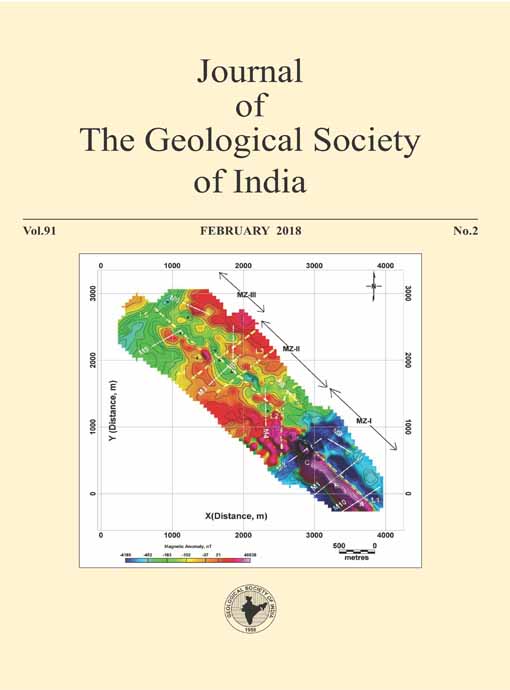A Study and Implications on the Potential of Satellite Image Spectral to Assess the Iron Ore Grades of Noamundi Iron Deposits Area
DOI:
https://doi.org/10.1007/s12594-018-0840-yAbstract
Jharkhand is well known for the largest iron deposits in India. Noamundi is the main deposit, which is associated with shale, keolinite. The rock succession exposed in the southern Singbhum and Keonjhar and lying unconformably over the older metamorphics are known as Iron Ore Series (Ravindrakumar, 1986). This paper relates the assessment of grades of iron ore of the area. The study involves with pre-processing, FLAASH (Fast Line-of-Sight Atmospheric Analysis of Spectral Hypercubes) Atmospheric correction algorithms of EO-1 Hyperion data and evaluating the spectral characteristic by using ENVI 4.7 software package. The position of peak reflectance and absorption trough, continuums removal and absorption band depth are considered for assessment the spectral characters. The strong absorption observed is between the 860 to 900nm wavelength region and peak reflectance is observed in the 750 to 780nm wavelength region of the image spectra. The position of the NIR absorption trough shift to the direction of the longer wavelengths is due to decrease of iron content. Higher values of band depth indicate a better possibility of the iron occurrence. As a result, this spectral study enables the possibility to differentiate the grades of iron ores from hyperspectral satellite images.Downloads
Metrics
Issue
Section
Downloads
Published
How to Cite
References
Clark, R.N. and Roush, T.L. (1984) Reflectance spectroscopy: quantitative analysis techniques for remote sensing applications. Jour. Geophys. Res., v.89 (B7), pp.6329-6340.
Clark, R.N. (1999) Chapter 1: Spectroscopy of Rocks and Minerals, and Principles of Spectroscopy. In: A.N. Rencz, (Ed.), Manual of Remote Sensing, Vol.3, Remote Sensing for the Earth Sciences. John Wiley and Sons, New York, pp.3-58.
Clark, R.N., Swayze, G.A., Wise, R., Livo, K.E., Hoefen, T.M., Kokaly, R.F. and Sutley, S.J. (2003) The USGS, Digital Spectral Library, U.S. Geological Survey Open File Report 03-395.
Das, I.C. (2004) Spectral signatures and spectral mixturemodeling as a tool for targeting aluminous laterite andbauxite ore deposits, Koraput, India. EO-1/ Hyperion Science Data User's Guide, May 2001.
Fischer, E. and Pieters, C.M. (1995), Lunar surface aluminum and iron concentration from Galileo solid state imaging data, and the mixing of mare and highland materials. Jour. Geophys. Res., v.100 (E11), 23279– 23290. doi:0148- 0227/95/95JE-023595.
Goodenough, G.D., Dyk, A., Niemann, O.K. and Pearlman, J.S. (2003) Preprocessing Hyperion and ALI for forest classification. IEEE Trans. Geoscience and Remote Sensing, v.41(6), pp.1321-1331.
Hunt, G.R., Salisbury, J.W. and Lenhoff, C.J. (1971) Visible and near inferade spectra of mineral and rocks: III. Oxides and hydroxids, Modern Geology, v.2, pp.195-205.
Horn, B.K.P. and Woodham, R.J. (1978) De-striping satellite image, Massachusetts Institute of Technology (Artificial Intelligence laboratory), A. I. Memo No. 467, March 1978, pp. 1-31.
Hapke, B. (1993) Introduction to the Theory of reflectance and Emittance Spectroscopy, Cambridge University Press, New York.
Karmanov, I.I. (1970) Study of soil from spectral composition of reflected radiation, Soviet Soil Science, v.4, pp.226- 238.
Magendran, T. and Sanjeevi, S. (2013) A Study on the Potential of Satellite Image-derived Hyperspectral Signatures to Assess the Grades of Iron ore Deposits. Jour. Geol. Soc. India, v.82(3), pp.227-235.
Ray, A.K., Ruikar, M.R. and Pande, S.C. (1979) Manual of Procedure for Chemical and Instrumental Analysis of Ores, Minerals, Ore Dressing Products and Environmental Samples, Ministry of Steel & Mines, Indian Bureau of Mines.
Saha, A.K. (1994) Crustal Evolution of Singhbhum-North Orissa, Eastern India. Mem. Geol. Soc. India, No.27, p.327.
Schmidt, K.S. and Skidmore, A.K. (2001) Exploring spectral discrimination of grass species in African rangelands. Internat. Jour. Remote Sensing, v.22, pp.3421-3434.
San, B.T. and Suzen, M.L. (2007) Comparison of atmospheric correction techniques for hyperion data, Turkey. (http://www.isprs2007ist.itu.edu.tr/ prog_8 may07.pdf). TATA Iron and Steel Company LTD. Volume I.
Van der Meer, F., Vazquez-Torres, M. and Van dijk, P.M. (1997) pectral characterization of ophiolite lithologies in the Troodos Ophiolite complex of Cyprus and its potential in prospecting for massive sulphide deposits. Internat. Jour. Remote Sensing, v.18(6), pp.1245-1257.

 Surajit Panda
Surajit Panda






